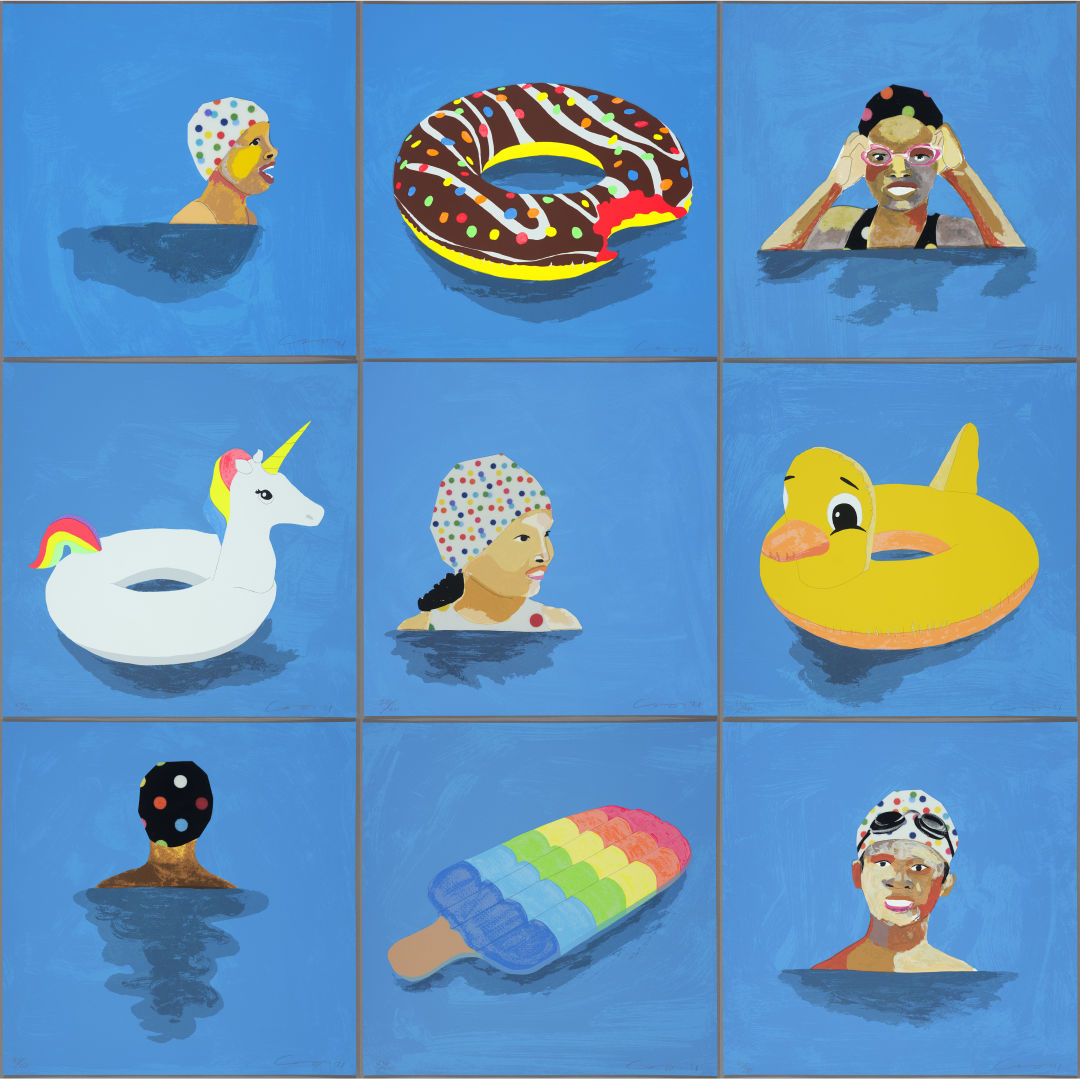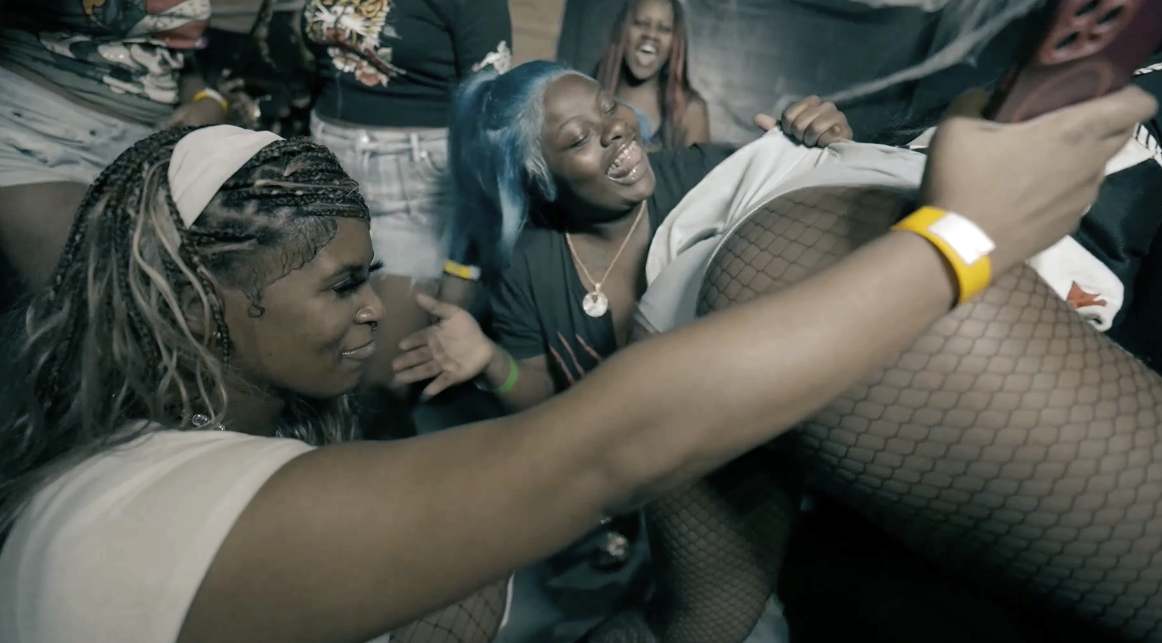The Politics of an Art Exhibit Devoted to Play

Installation view of works from Derrick Adams’s Floater series, inspired by a picture the artist found of Martin Luther King Jr. swimming.
In Jelly Belly script on the entryway wall, the title Just Playin’ Around announces the latest show at the Jordan Schnitzer Museum of Art at Portland State University. Going off the jesting title, and artist Joshua Sin’s pair of totem-like stuffed animal towers sitting beside it (they’re titled Power Up; you’re meant to hug them), it would be easy to write the show off as merely amusing, or worse, dismiss it as frivolous. But play, the theme connecting the show’s cast of 11 international artists, is something of a Trojan horse.
In industrialized societies, play is “only worth it if you can monetize it,” the show’s cocurator Theo Downes-Le Guin told me. “—Or a luxury that you only can do if you have the resources,” added his wife and cocurator Nancy Downes-Le Guin. Both see this lack of respect for play as the fatal flaw of market-driven societies. Playing around with no productive goal in sight has been a facet of every civilization as far back as Ancient Egypt and Mesopotamia, and for good reason: Prevailing sociological thought views play as critical to forming and maintaining cultures, as a bonding, learning, and problem solving exercise. To bring things into the present, Theo puts it like this: “Activities that are pointless to capitalism are not necessarily pointless to humanity.”

Flowers (Superflat) by Takashi Murakami.
And that is about as fine of a point as the curators are interested in putting on this show. Several brashly cartoonish yet endearing prints by the Japanese celebrity artist Takashi Murakami signal one end of its spectrum, while New York artist Derrick Adams’s series of screen-printed paintings, inspired by a photo of Martin Luther King Jr. taking a swim, might signal the other (you don’t often see MLK in an innertube). Other works take up video games, sports, toys, corporate America, and child labor to represent play’s function in modern culture, and the trouble with forgoing it, especially in the grips of political turmoil. Play! It’s all kinds of good for you, is the message. The curators don’t dare tell a viewer what they should or shouldn’t do with their playtime.

A group of prints from Derrick Adams’s Floaters series.
Assembling the show, the Downes-Le Guins noticed almost every artist they visited equated play with the ever elusive flow state: that creative moment of ease when inhibitions dissipate and inspiration and digested knowledge take over. Viewed a certain way, you could call this state freedom. Theo’s mother, the massively influential author Ursula K. Le Guin (1929–2018), was famous for the ways she explored the tenets of freedom in her speculative fiction. Carrying some of her insights, Theo is quick to mention that nearly every culture, historical or fantastical, has taken to playing games and making art immediately after securing food and shelter. In an industrialized culture of optimization, however, play’s benefits are less immediately tangible than, for instance, profit.
The result is a harshly critical societal view of play. Activities that you play, instead of simply do, are ousted from the realm of serious business. The word implies fiction, practice, play-acting for some eventual real-life corollary. Play is the opposite of work and therefore worthless.

Installation view of Just Playin’ Around. At right, Power Up by Joshua Sin.
Except when you’re a kid, of course. Portland artist Joshua Sin’s huggable pillars of discarded stuffed animals take advantage of this tender memory space. Sin pieced apart over a hundred plushies—stuffed frogs, unicorns, a smiling purple swirl of poop, and a rainbow-sequined dachshund among them—and meticulously stitched the toys into a pair of sculptures that look like snuggly Festivus poles. Conceptually, they’re in line with that Seinfeldian holiday’s critique of hollow consumerist joys, but there’s another bit. “How do you take an object that comforted and protected a child—and then has been discarded—how do you reanimate it in a way that can comfort people anew?” Nancy explains.

Cornfield by Calvin Chen.
Portland photographer Calvin Chen approaches child’s play with a more somber tone. In Cornfield, an unused soccer ball sits next to a small child picking through an endless run of corn cobs. The print is a modest size, but it’s a humongous picture. The field seems to expand past the edges of the photo forever, magnifying the juxtaposition of play (the ball) and work (the corn). The ball itself also comes to represent childhood more thoroughly than the actual kid in this dissonant child labor scene.
The ball also brings up sports, the great exception when it comes to the value society places on play. Jeremy Okai Davis’s portraits of Marshall Major Taylor, the nineteenth-century star track cyclist, and Althea Gibson, the pioneering midcentury tennis and golf pro, both of whom were Black, speak more directly to sport’s function in our society. Instead of championing tennis and cycling, Davis’s paintings resurrect histories handicapped by racism. In doing so, they bring up one of the earliest and most impactful pathways toward desegregation. Why is it that playing sports is so integral to modern life, while playing games, and playing around making art, is extracurricular?

Crown (Althea Gibson) by Jeremy Okai Davis.
While clarifying that he doesn’t love the book, Theo mentions James P. Carse’s Finite and Infinite Games to help explain. According to Carse, sports, as well as politics and war, are finite games: competitions with clear rules and clearer winners. Every other pursuit, including art and even life itself, is an infinite game. In these, rules are perpetually in flux, you play in order to keep playing, and, more often than not, it’s impossible to tell how well you’re doing. The tidy metrics of sports line up nicely with capitalist systems. Yet attempting to make the infinite game of life a finite game—applying the neatly legible stats of, say, a tennis match to existence itself—has its downsides. “In the end, winning and losing is binary,” Theo says, “and binarism has its limitations as a world view.” As Davis’s pictures make clear, sporting rules aren’t necessarily fair either.

Installation view of Just Playin’ Around. At right, They are all equal now by Heidi Schwegler.
The artist Heidi Schwegler, who lives in California’s Yucca Valley, looked to bugs for playful inspiration, asking, Do cockroaches play? Across countless fields of study, trying to understand how and why animals and insects do things—play, in this case—is a helpful abstraction to understand how and why humans do things. It’s also a good exercise in interspecies empathy, as the resulting sculptural installation’s cheekily sinister title, They are all equal now, suggests. The piece involves both a sculptural tableau and a video of the scene in motion. Next to several larger-than-life metal insect sculptures, which sit in miniature bumper cars, a video of those same buggies motoring around plays projected against a small box. The catch is you have to stoop to cockroach-eye-level to watch the bugs play with human toys.
Though he hopes he has a good sense of humor (“one never knows”), Theo says curating this exhibition forced him to confront his own biases. Despite best intentions, he admits he’s always felt seriousness and play were “at odds with each other.” A year-and-change of studying play quite seriously later, he feels differently, and now calls play a “deadly serious” act of creativity, subversion, and resistance.
Nancy, who also works in early childhood development, didn’t need convincing. “Play can help you get unstuck,” she says. “We’re in a time where a lot of people feel very stuck in their views, or their abilities to affect any kind of change; play is a way to unlock that.” Play is a kind of cognitive escape to an extra-reality, one that’s proven itself as a generative or soothing or joyful resource for millennia. “My mother always said, ‘What is escape but the search for freedom?’” Theo says, “and who doesn’t want and deserve freedom?”
Share this content:















Post Comment